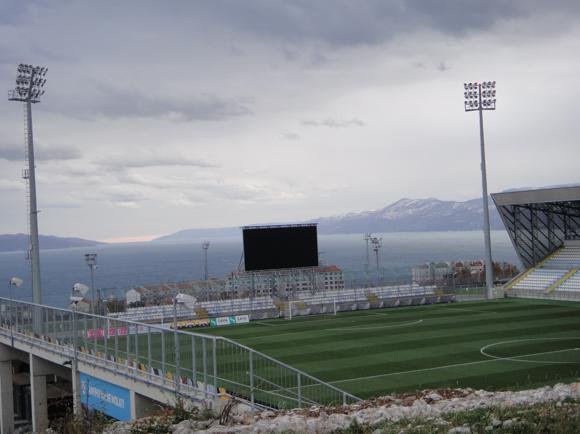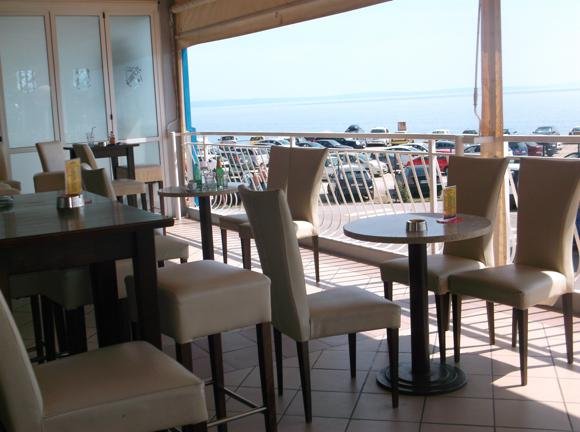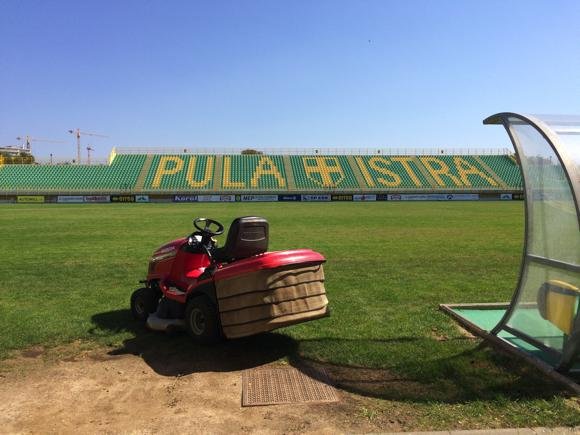A fan’s guide – the club from early doors to today
With a passionate fan base and ambitious, oil-rich Italian owner, HNK Rijeka broke Zagreb’s grip on the Croatian game in 2017. A vital win on the last day of the campaign saw Dinamo outgunned for the first time in 11 years and the title come to the deep-water port and transport hub of Rijeka for the first time.
In 2013, Ligurian entrepreneur Gabriele Volpi, a naturalised Nigerian who made his millions in oil, bought 70 per cent of HNK Rijeka for 54 million kuna (about €7 million), leaving 30 per cent for the City of Rijeka. Volpi had already invested part of his fortune in the waterpolo team of his native Recco and nearby Spezia Calcio, who narrowly missed out on a Serie A place this June.
Selling key striker Andrej Kramarić to Leicester for a club record €13.5 million in January 2015, Volpi sees value in overseeing a club with a relatively straightforward passage to Europe each season.

The next task concerns the legendary Kantrida stadium, set right on the beach, undergoing a complete reconstruction. During that time, the Whites are playing at the Stadion Rujevica, just the other side of the main Kvarner highway, halfway between the Kantrida and Rijeka train station. This former training pitch has been reconfigured for medium-term use, also gaining the name HNK Rijeka Stadium.
With the Kantrida and Italian influence in focus, everything has come full circle where football is concerned in Rijeka. HNK originated from US Fiumana, who represented what was the city of Fiume between the wars. The border between Italy and the new Socialist state of Yugoslavia moved after 1945. Fiume became Rijeka, and the football club became NK Kvarner, after the region. They inherited most of Fiumana’s players as well as the dramatic Kantrida stadium.

Hewn from a stone quarry and set by the beach of the same name, the Kantrida saw top-flight league action after NK Kvarner became NK Rijeka in the mid 1950s. A decent force in the Yugoslav game in the late 1970s, when Čiro Blažević of 1998 World Cup fame was in charge for 18 months, Rijeka won two domestic cups, held Juventus to a 0-0 draw and beat Real Madrid 3-1 at the Kantrida.
From 1987, a fiery supporters’ group, the Armada, adopted the trends of Italian ultra groups, but European football eluded the Whites for more than a decade. After Croatian independence, the newly named HNK Rijeka took a while to adapt to more modest regular opposition.
Despite frequent changes of management – current incumbent Matjaž Kek has excellent international experience with Maribor and the Slovenian national team – Rijeka began to win silverware again. Two consecutive cup wins came in 2005 and 2006 but it wasn’t until 2013 that they again shone in Europe. Overcoming VfB Stuttgart in a play-off, Rijeka made the group stage of the Europa League to hold Lyon, Betis and Guimarães to draws at home.

It was then that the prolific Andrej Kramarić began to get noticed. This time beating Standard Liège and Feyenoord at the Kantrida, Kramarić scoring a hat-trick against the Rotterdammers, Rijeka showed their mettle. Despite the sale of Kramarić halfway through, the Whites beat Hajduk by a country mile to a second spot in the Croatian top flight in 2014-15. Kramarić ended the season as top league scorer.
Also runners-up a year later, Rijeka set a fast pace in 2016-17 in their bid to wrest the title from Zagreb. Having poached striker Franko Andrijašević, formed at Hajduk, flopped at Dinamo, HNK loaned out Albanian attacker Roman Bezjak to Darmstadt. With a solid defence backed by returning goalkeeper Andrej Prskalo and a midfield spearheaded by Alexander Gorgon, an Austrian Bundesliga title-winner in 2013, Rijeka went unbeaten from July until May.

With Mario Gavranović, a Swiss international of Bosnian-Croat extraction, gaining prominence and welcoming the on-loan return of Bezjak after Christmas, Rijeka withstood a strong challenge by Dinamo in the spring to win a memorable title.
With sale of Andrijašević to Gent, Rijeka struggled to retain their crown – and, despite the legal chaos engulfing Dinamo Zagreb, remained Croatia’s de facto second club, usurping Hajduk Split. A narrow defeat to Olympiacos prevented lucrative participation in the Champions League group stage, although the Croatian Cup win of 2019 under ex-Liverpool star Igor Bišćan ensured a seventh straight European campaign.







Stadium Guide
The field of dreams – and the stands around it







The rebuilding of the legendary Kantrida stadium, due to open in 2018, has made way the expansion and improvement of the Rujevica at Rijeka’s training camp. The ground is now referred to as the HNK Rijeka Stadium.
Set north-east of the Kantrida, just the other side of the E61 highway that runs from southern Austria to the Adriatic, Rujevica was built in the summer of 2015 as a temporary replacement. Rijeka’s success in 2016-17 has forced the club to add a roofed north stand behind one goal, complementing two sideline stands, one partly covered.
Overall capacity has risen to 8,300, from the 6,000 that squeezed into the Rujevica for major home games in the title run of 2017. Away fans are allocated the narrow, 400-seat terrace behind the south (Jug, sektor J) goal.

Surrounded by training fields, the Rujevica still enjoys the same view of the Adriatic as the Kantrida did – from the new north stand at least. In 2018, it suffered the strange fate of hosting a behind-closed-doors international between Croatia and England, bereft of spectators and, it would turn out, goals.
The new Kantrida will be an all-roofed affair of 14,000 capacity, with 4,000 places for home fans, 1,000 seats in the family zone and an underground car park. All a far cry from the revered original ground, once a stone quarry until a pitch was created in 1911. It was here that the first side from Rijeka, from the Croatian neighbourhood of Sušak, played – and here that the local Italian side, US Fiumana, also strode out.
getting there
Going to the stadium – tips and timings



Both Rujevica and the Kantrida are in the far west of town, past the train station.
Rujevica Stadion has its own stop on bus route 7A, which calls at Riječki nebođer by the focal square of Jadranski trg in the city centre and Brajda near the train station. From town, the end terminus is Hosti. On the way back, the 7A leaves from Rujevica, a different stop close to the ground on the city side. This also serves the 7 that follows a similar route from town.
On the way back into the city, both routes visit the train station, Željeznički kolodvor, the bus hub of Žabica and the Riva seafront. Buses run every 25-30mins until after 10pm, including Sundays – the 7 is a little more frequent.
A taxi from town should cost around 40kn/€5.30.
For the Kantrida, the 1 bus (direction Bivio) runs every 15mins from town, and calls at the bus and train station en route.
getting in
Buying tickets – when, where, how and how much


The expanded capacity at the Rujevica has helped with demand – major league games in 2016-17 saw the gate touch its 6,000 capacity. The club has no online sales.
For advance purchases, your best bet is to try the club shops in town and at the Kantrida (see below, What to buy). Rijeka also have an office at Rujevica.
For league games against lesser teams, ie everyone but Dinamo and Hajduk, tickets are available on the day, entrance around 60kn/€8.
what to buy
Shirts, kits, merchandise and gifts


The HNK Rijeka Fan Shop is by the main drinks kiosk at the Rujevica, near the car park, open on match days.
There’s another shop at the Kantrida stadium (Mon-Fri 4pm-7pm) in the city centre (Mon-Fri 9am-8pm, Sat 9am-1pm), at P Rittera Vitezovića 1, just tucked in from the canal.
Where to Drink
Pre-match beers for fans and casual visitors








Two venues sit close to Rujevica, behind the away end. The Docker Pub at Rujevica 6 is a perfect find, with TV sport, a range of beers and a sun-catching terrace. Note also the retro Yugo pennants around the bar area
Close by, down the slope, the Lovorka is heaven for carnivores, a classic Balkan grill with favourites such as ćevapi and pljeskavica on the menu. It also has a big terrace, and serves Croatian Karlovačko on draught. Armada fans have their own little bar, Način života, on the same side of the ground.
On the main road, by the last bus stop before you reach the stadium, a row of cafés includes the Donatello (Antuna Barca 10), lively pre-match, while the next door Riba Stan is great for pre-match eats. These are a 10min walk from the ground, just head below the overpass.

At the ground, behind the main stand, a kiosk dispenses Ožujsko beer.
The Kantrida is surrounded by bars and restaurants. On the main road near the bus stop, HAD (Liburnijska 18) is a sturdy bar/restaurant and HNK fans’ hangout, with team line-ups and old photos of the Kantrida on the walls. Further along on the same side, Miramare (1.Maja 12) is an equally affordable fish restaurant, with a sadly underused terrace.
Behind the home, Armada end of the stadium, Stars (Portić 1) is a more contemporary bar-cum-nightclub, whose terrace hangs right over the stadium.
Depending on current construction, two bars sit by the main entrance to the Kantrida. Down below, at street level, the KN Armada is a small fans’ bar, decked out in scarves and pennants. Above, the Pod Kavun has a terrace with a stunning view of an endless Adriatic. Team line-ups through the ages line the walls, with a display of trophies on the other side of the bar.
From there, it’s a few steps down to the sea, where you’ll also find the Morski Prasac beach bar, ideal for a sundowner before evening kick-off.








